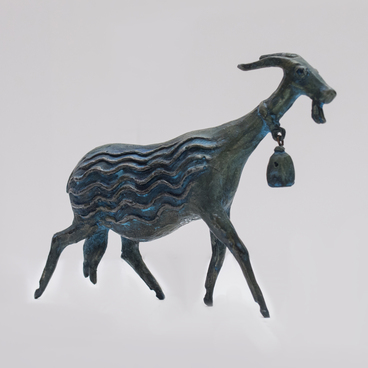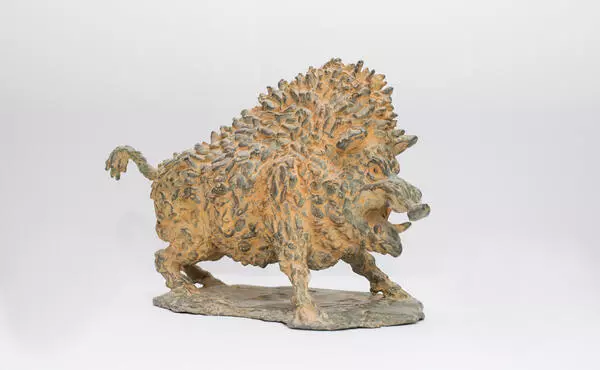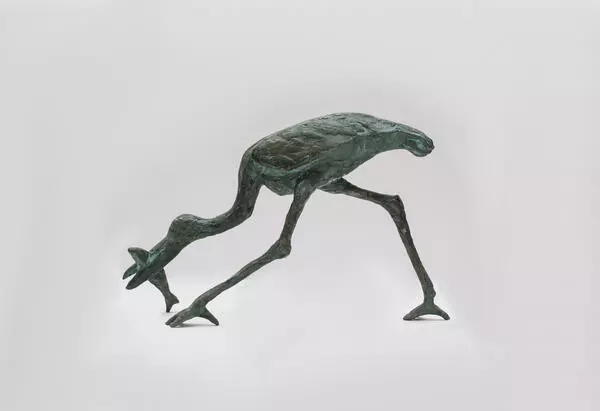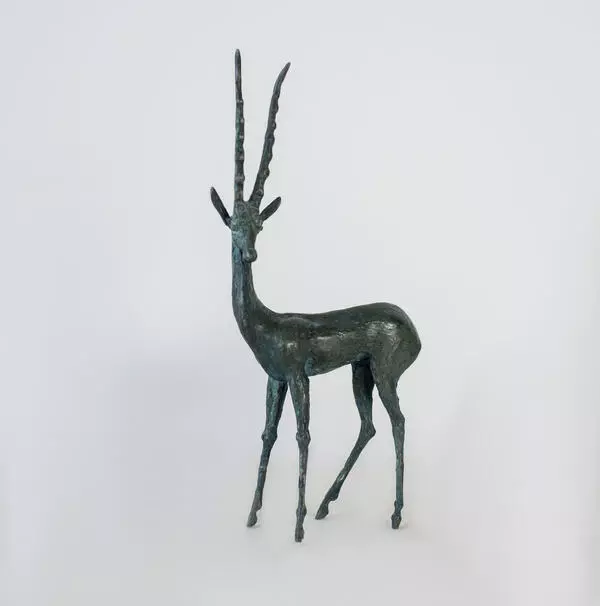The Volzhsky Art Gallery houses a metal figurine of a wildebeest, created by Andrey Martz in 1993.
Such works are classified as small plastic arts. They are small three-dimensional porcelain and ceramic sculptures or cast metal items. Back in the 1950s, such sculptures became an important element of the Soviet interior. Because of them people could add individuality to their typical apartment blocks. The most popular included statuettes of leaders, workers, especially women, children, athletes, fairytale characters and real animals.
Andrey Martz depicted the antelope outstretched in a motion: it is preparing to attack. It has slender legs and a stout, dense body. Its heavy head, which looks like a bull’s head, is adorned with strong horns.
The antelope’s hind legs are spaced widely, with the weight of the body transferred to one outstretched front leg and the other one is bent and lifted up. The head is down, the curved horns are forward, and the tail is twisted in a loop.
Russian and Soviet animalier Andrey Martz was born on June 26, 1924, in Moscow. He studied at the Moscow Secondary Art School from 1939 to 1943, and afterwards, in 1946, he entered the Moscow State Academic Art Institute named after V. I. Surikov. His teachers were graphic artist Pavel Pavlinov, sculptor Romuald Iodko, and sculptor-monumentalist Nikolai Tomsky. Martz graduated from the Institute in 1952.
Since 1966, Andrey Martz took part in many regional, all-Russian, all-Union and international exhibitions and biennales. In the same year, he won the Russian Soviet Federative Socialist Republic (RSFSR) Art Fund small plastic arts competition, and the Fund started to produce plastic figurines based on his models. In 1983, the artist was awarded the title Honored Artist of the RSFSR.
Taking classical examples of animalistic sculpture as a foundation, Martz departed from the canons of Realism in his work. In his sculptures he often used “grotesque” — bizarre compositions, fantastic elements, unnatural poses and behavior of animals.
Works by Andrey Martz are housed in the Tretyakov Gallery, the Russian Museum in St. Petersburg, the Darwin Museum, the Timiryazev Biology Museum, and other institutions of culture.
Such works are classified as small plastic arts. They are small three-dimensional porcelain and ceramic sculptures or cast metal items. Back in the 1950s, such sculptures became an important element of the Soviet interior. Because of them people could add individuality to their typical apartment blocks. The most popular included statuettes of leaders, workers, especially women, children, athletes, fairytale characters and real animals.
Andrey Martz depicted the antelope outstretched in a motion: it is preparing to attack. It has slender legs and a stout, dense body. Its heavy head, which looks like a bull’s head, is adorned with strong horns.
The antelope’s hind legs are spaced widely, with the weight of the body transferred to one outstretched front leg and the other one is bent and lifted up. The head is down, the curved horns are forward, and the tail is twisted in a loop.
Russian and Soviet animalier Andrey Martz was born on June 26, 1924, in Moscow. He studied at the Moscow Secondary Art School from 1939 to 1943, and afterwards, in 1946, he entered the Moscow State Academic Art Institute named after V. I. Surikov. His teachers were graphic artist Pavel Pavlinov, sculptor Romuald Iodko, and sculptor-monumentalist Nikolai Tomsky. Martz graduated from the Institute in 1952.
Since 1966, Andrey Martz took part in many regional, all-Russian, all-Union and international exhibitions and biennales. In the same year, he won the Russian Soviet Federative Socialist Republic (RSFSR) Art Fund small plastic arts competition, and the Fund started to produce plastic figurines based on his models. In 1983, the artist was awarded the title Honored Artist of the RSFSR.
Taking classical examples of animalistic sculpture as a foundation, Martz departed from the canons of Realism in his work. In his sculptures he often used “grotesque” — bizarre compositions, fantastic elements, unnatural poses and behavior of animals.
Works by Andrey Martz are housed in the Tretyakov Gallery, the Russian Museum in St. Petersburg, the Darwin Museum, the Timiryazev Biology Museum, and other institutions of culture.





